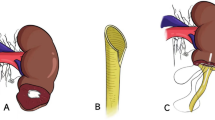Abstract
Introduction
Complex ureteric strictures present a significant challenge to the endourologist and uro-radiologist. Multiple separate interventions to try to cross the stricture are often attempted. We describe our experience managing a heterogenous patient group using the ‘rendezvous’ procedure.
Methods and materials
16 patients and 18 ureters (one bilateral procedure, and two separate procedures in one patient) underwent rendezvous procedures. Seven patients had coexisting ureteric calculi treated. Each case was followed up for between 3 months and 5 years.
Results
In 16/18 ureters there was technical success at time of surgery; successfully crossing the stricture, allowing ureteroscopic access to the ureter, dilating and/or stenting the ureter. 2/18 were unsuccessful; one secondary to advanced malignancy resulting in a uretero-vaginal fistula and the second a failure to remove a retained, displaced ureteric stent. Of the 18 ureteric procedures; 7/18 were stent free at 3 months, improving to 8/18 stent free at 6 months. 4/18 remained nephrostomy dependent (failure of drainage despite stent or failure to stent) at 3 months, increasing to 6/18 being nephrostomy dependent at 6 months. 1/16 remained dialysis dependent with a nephrostomy tube. For those procedures involving ureteric calculi, 6/7 were stone free and 1/5 had a persistent stone fragment requiring further intervention.
Conclusions
A combined approach may decrease the number of separate interventions required, with the aim of removing the need for a long-term nephrostomy, as well as providing opportunity to treat ureteric calculi in the context of stricture disease. Our experience has been that where the rendezvous has been required to treat strictures caused by malignant extrinsic compression, stenting has not been successful; this information is key to informed consent in a group of patients who may have a limited life expectancy.



Similar content being viewed by others
References
Bagley DH, Huffman J, Lyon E et al (1985) Endoscopic ureteropyelostomy: opening the obliterated ureteropelvic junction with nephroscopy and flexible ureteropyeloscopy. J Urol 133:462–464
Watson JM, Dawkins GPC, Whitfield HN et al. 2002 The rendezvous procedure to cross complicated ureteric strictures. BJU Int 89(3):317–319
Anderson H, Alyas F, Edwin PJ (2005) Intra-urinoma rendezvous using a transconduit approach to re-establish ureteric integrity. Cardiovasc Intervent Radiol 28:95–97
Doody O, Given MF, Harper M et al (2008) Rendezvous technique following thermal ureteric injury after radiofrequency ablation in a solitary kidney. J Vasc Interv Radiol 19(7):1112–1114
Pastore AL, Palleschi G, Silvestri L et al. 2015.Endoscopic rendezvous procedure for ureteral iatrogenic detachment: report of a case series with long-term outcomes. J Endourol 29(4):415–420
Liu C, Zhang X, Xue D et al. 2014.Endoscopic realignment in the management of complete transected ureter. Int Urol Nephrol 46:335–340
Delvecchio FC, Kuo RL, Iselin CE et al (2000) Combined antegrade and retrograde endoscopic approach for the management of urinary diversion associated pathology. J Endourol 14(3):251–256
Lopatkin NA, Martov AG, Gushchin BL (2000) An endourologic approach to complete ureteropelvic junction and ureteral strictures. J Endourol 14(9):721–726
Gray RJ, Intriere L, Dolmatch BL et al (1992) Combined retrograde antegrade ureteral stent passage: salvage procedure for a ureteral leak. J Vasc Interv Radiol Aug 3(3):557–558
Macri A, Magno C, Certo A et al (2006) Combined antegrade and retrograde ureteral stenting: the rendezvous technique. Clin Radiol 60:257–260
Yates DR, Mehta SS, Spencer PA et al (2010) Combined antegrade and retrograde endoscopic retroperitoneal bypass of ureteric strictures: a modification of the ‘rendezvous’ procedure. BJU Int 105:992–997
Mazzon G, Arumuham V, Dale R, Bolgeri M, Allen S, Smith D, Choong S (2017) The ureteric rendezvous procedure to treat complex discontinuities. J Urol A 176
Author information
Authors and Affiliations
Contributions
Deverill—data collection and writing. Osborne, Woodhouse, Shennoy—performed cases. Johnston—manuscript editing. Keoghane—senior author, surgeon, editing and project developer.
Corresponding author
Ethics declarations
Conflict of interest
The authors have no conflicts of interest.
Informed consent
Informed consent was obtained from patients prior to each operation.
Rights and permissions
About this article
Cite this article
Keoghane, S.R., Deverill, S.J., Woodhouse, J. et al. Combined antegrade and retrograde access to difficult ureters: revisiting the rendezvous technique. Urolithiasis 47, 383–390 (2019). https://doi.org/10.1007/s00240-018-1070-x
Received:
Accepted:
Published:
Issue Date:
DOI: https://doi.org/10.1007/s00240-018-1070-x




